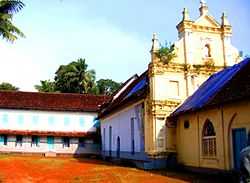Mar Hormiz Syro-Malabar Catholic Church, Angamaly
| Mar Hormiz Syro-Malabar Catholic Church, Angamaly | |
|---|---|
|
Mar Hormiz (Hormizd) Syro-Malabar Catholic Church (Old Cathedral) | |
 Mar Hormiz Syro-Malabar Catholic Church, Angamaly | |
| 10°11′26″N 76°22′58″E / 10.1906°N 76.3828°ECoordinates: 10°11′26″N 76°22′58″E / 10.1906°N 76.3828°E | |
| Location | Angamaly, Kerala |
| Country | India |
| Denomination | Syro-Malabar Catholic Church[1] |
| Website | http://www.angamalybasilica.com |
| History | |
| Former name(s) | Mar Hormizd Metropolitan Cathedral |
| Founded | 1567 |
| Founder(s) | Mar Abraham, Metropolitan and the Gate of All India |
| Dedication | Hormizd Rabban |
| Dedicated | 1567 |
| Consecrated | 1567 |
| Cult(s) present | former cathedral of Saint Thomas Christians |
| Relics held | Mar Abraham |
| Past bishop(s) | Mar Abraham |
| Associated people | Saint Thomas Christians |
| Architecture | |
| Status | Filial[2] |
| Administration | |
| Archdiocese | Syro-Malabar Catholic Major Archeparchy of Ernakulam-Angamaly |
| Clergy | |
| Archbishop | Mar George Alencherry |
Mar Hormizd Syro-Malabar Catholic Church, Angamaly is a church located in Angamaly, Kerala, India. It was established in 1570 by Mar Abraham, the last Chaldean Metropolitan to reach Malabar Coast.[3] It is dedicated to Mar Hormizd, a seventh century Chaldean saint.[4][5]
History
Mar Abraham who came to Malabar in 1570 settled in Angamaly as his See to govern the Saint Thomas Christians. Its jurisdiction was extended whole over India till the 16th century. The most ancient University for Malpan training was established at Angamaly before the arrival of the Portughese. The Chaldean bishop Mar Abraham was ordained as the Metropolitan and the Gate of All India and Rabban Hormiz Church was the Cathedral church.[6]<ref name="Du Jarric, "Rer. Ind. Thesaur.", tom. III, lib. II, p. 69">Du Jarric, "Rer. Ind. Thesaur.", tom. III, lib. II, p. 69</ref> This title denotes a Quasi Patriarchal status with all India jurisdiction.[7][8]
The church houses the tomb of Mar Abraham who died in 1597.[9][10][9]
Mar Hormizd Church, built by Mar Abraham
After having made a successful escape from the Portuguese detention in Goa, Mar Abraham returned to Angamaly in 1570. In the same year, Mar Abraham built his first Cathedral Church namely Rabban Hormizd, a seventh century Abbot of the East Syrian Church, as its patron.

In 1578, as a response to the requests made on the part of the Jesuit missionaries who had been working in Angamaly and in the other centres of the Christians of St. Thomas, the pope sent plenary indulgences to the Church of Rabban Hormizd which the faithful could obtain four times a year for 25 years from the year of the election of the Metropolitan Mar Abraham. The indulgences covered two feasts of the Patron Rabban Hormizd that fell on the fifteenth day after Easter (Monday) and on the first of September. On 15 August 1579, as requested by Mar Abraham, the Jesuits laid the foundation stone of a new Cathedral Rabban Hormizd in the same place that was chosen by the Metropolitan. The Synod of Diamper of the year 1599, prohibitted the Christians that they should not commemmorate the feast of Rabban Hormizd anymore among the Christians of St. Thomas, since Rabban Hormizd was counted as a Nestorian heretic by the Latin missionaries. The new regulations came into effect on the basis of the Session 2, Canon 10 and Session 3, Canon 14 of the Synod of Diamper. According to Session 2, Canon 10 a new patron was presented to the Cathedral of Mar Abraham: Saint Martyr Hormizd, a Persian who embraced martyrdom for his faith in Christ, in fifth century. The present East Church of Angamaly, which was once the Cathedral of all the Christians of St. Thomas is dedicated to Martyr Hormizd, a Catholic saint, whose name is present in the official Roman Martyrology. The Church is known today as St. Hormis.[11]
References
- ↑ http://www.syromalabarchurch.in/parish.php?id=276
- ↑ http://www.ernakulamarchdiocese.org/churches.php?page=1
- ↑ Encyclopaedia of sects & religious doctrines, Volume 4 By Charles George Herbermann page 1180,1181
- ↑ Fr. Varghese Pathikulangara CMI (2011). Divine Praises in Aramaic Tradition (PDF). Kottayam: Denha Services. p. 48. ISBN 978-93-81207-02-4.
- ↑ http://angamalybasilica.com/template.php?id=35&page=8&catid=72
- ↑ Du Jarric, tom. I, lib. II, p. 614
- ↑ Joseph Thekkedathu, pous cit pp96-100
- ↑ Rev Dr Placid Podipara, The Hierarchy of Syro Malabar Church, in Collected works of Rev Dr Placid Podipara CMI, Vol I p 719
- ↑ 9.0 9.1 Language of religion, language of the people: medieval Judaism, Christianity, and Islam,Ernst Bremer, Susanne Röhl Page 401
- ↑ http://www.nasrani.net/2007/07/31/book-reviewthe-nazranies-by-prof-george-menanchery/
- ↑ Mechery, Antony. S.J. "Padiyirangunna Prathishtakalum Chila Charithravicharangalum." Sathyadeepam Weekly, 88 (March 2015): 4, 16.
See also
- St. George Syro-Malabar Catholic Basilica, Angamaly
- Kottakkavu Mar Thoma Syro-Malabar Pilgrim Church, North Paravur
- India (East Syrian Ecclesiastical Province)